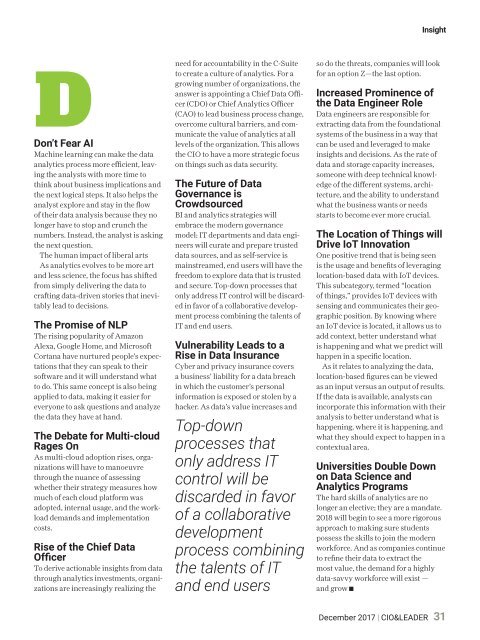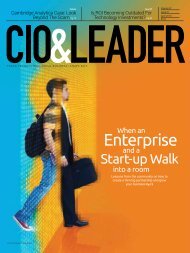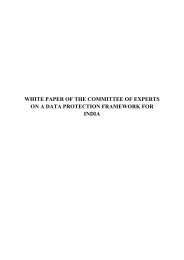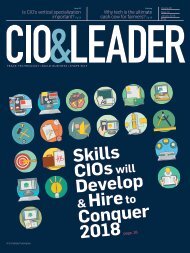C&L_December 2017 (1)
Create successful ePaper yourself
Turn your PDF publications into a flip-book with our unique Google optimized e-Paper software.
Insight<br />
D<br />
Don’t Fear AI<br />
Machine learning can make the data<br />
analytics process more efficient, leaving<br />
the analysts with more time to<br />
think about business implications and<br />
the next logical steps. It also helps the<br />
analyst explore and stay in the flow<br />
of their data analysis because they no<br />
longer have to stop and crunch the<br />
numbers. Instead, the analyst is asking<br />
the next question.<br />
The human impact of liberal arts<br />
As analytics evolves to be more art<br />
and less science, the focus has shifted<br />
from simply delivering the data to<br />
crafting data-driven stories that inevitably<br />
lead to decisions.<br />
The Promise of NLP<br />
The rising popularity of Amazon<br />
Alexa, Google Home, and Microsoft<br />
Cortana have nurtured people’s expectations<br />
that they can speak to their<br />
software and it will understand what<br />
to do. This same concept is also being<br />
applied to data, making it easier for<br />
everyone to ask questions and analyze<br />
the data they have at hand.<br />
The Debate for Multi-cloud<br />
Rages On<br />
As multi-cloud adoption rises, organizations<br />
will have to manoeuvre<br />
through the nuance of assessing<br />
whether their strategy measures how<br />
much of each cloud platform was<br />
adopted, internal usage, and the workload<br />
demands and implementation<br />
costs.<br />
Rise of the Chief Data<br />
Officer<br />
To derive actionable insights from data<br />
through analytics investments, organizations<br />
are increasingly realizing the<br />
need for accountability in the C-Suite<br />
to create a culture of analytics. For a<br />
growing number of organizations, the<br />
answer is appointing a Chief Data Officer<br />
(CDO) or Chief Analytics Officer<br />
(CAO) to lead business process change,<br />
overcome cultural barriers, and communicate<br />
the value of analytics at all<br />
levels of the organization. This allows<br />
the CIO to have a more strategic focus<br />
on things such as data security.<br />
The Future of Data<br />
Governance is<br />
Crowdsourced<br />
BI and analytics strategies will<br />
embrace the modern governance<br />
model: IT departments and data engineers<br />
will curate and prepare trusted<br />
data sources, and as self-service is<br />
mainstreamed, end users will have the<br />
freedom to explore data that is trusted<br />
and secure. Top-down processes that<br />
only address IT control will be discarded<br />
in favor of a collaborative development<br />
process combining the talents of<br />
IT and end users.<br />
Vulnerability Leads to a<br />
Rise in Data Insurance<br />
Cyber and privacy insurance covers<br />
a business’ liability for a data breach<br />
in which the customer’s personal<br />
information is exposed or stolen by a<br />
hacker. As data’s value increases and<br />
Top-down<br />
processes that<br />
only address IT<br />
control will be<br />
discarded in favor<br />
of a collaborative<br />
development<br />
process combining<br />
the talents of IT<br />
and end users<br />
so do the threats, companies will look<br />
for an option Z—the last option.<br />
Increased Prominence of<br />
the Data Engineer Role<br />
Data engineers are responsible for<br />
extracting data from the foundational<br />
systems of the business in a way that<br />
can be used and leveraged to make<br />
insights and decisions. As the rate of<br />
data and storage capacity increases,<br />
someone with deep technical knowledge<br />
of the different systems, architecture,<br />
and the ability to understand<br />
what the business wants or needs<br />
starts to become ever more crucial.<br />
The Location of Things will<br />
Drive IoT Innovation<br />
One positive trend that is being seen<br />
is the usage and benefits of leveraging<br />
location-based data with IoT devices.<br />
This subcategory, termed “location<br />
of things,” provides IoT devices with<br />
sensing and communicates their geographic<br />
position. By knowing where<br />
an IoT device is located, it allows us to<br />
add context, better understand what<br />
is happening and what we predict will<br />
happen in a specific location.<br />
As it relates to analyzing the data,<br />
location-based figures can be viewed<br />
as an input versus an output of results.<br />
If the data is available, analysts can<br />
incorporate this information with their<br />
analysis to better understand what is<br />
happening, where it is happening, and<br />
what they should expect to happen in a<br />
contextual area.<br />
Universities Double Down<br />
on Data Science and<br />
Analytics Programs<br />
The hard skills of analytics are no<br />
longer an elective; they are a mandate.<br />
2018 will begin to see a more rigorous<br />
approach to making sure students<br />
possess the skills to join the modern<br />
workforce. And as companies continue<br />
to refine their data to extract the<br />
most value, the demand for a highly<br />
data-savvy workforce will exist —<br />
and grow<br />
<strong>December</strong> <strong>2017</strong> | CIO&LEADER<br />
31














